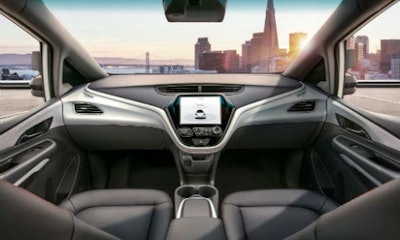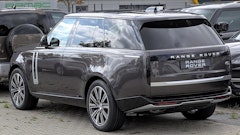
By Jeff Sanford
Toronto, Ontario — January 22, 2018 — In this week’s Autonomous Report, General Motor’s (GM) surprise announcement, Toronto’s AV study, Russia’s nuclear bomb-equipped underwater UAV, and much, much more.
– This past Friday GM, the old symbol of corporate sluggish and bureaucratic sloth, surprised the industry when it distributed a press release announcing it had “… filed a Safety Petition with the Department of Transportation for its fourth-generation self-driving Cruise AV, a production-ready vehicle built from the start to operate safely on its own with no driver, steering wheel, pedals or manual controls.”
That is, the biggest domestic auto industry OEM is getting ready to test a driverless car on real streets in the year ahead. That’s fast. Typical optimistic estimates a year ago suggested that true AVs will not appear before 2025. So much for timetables. The vehicle will be known as the Cruise AV, and, according to a news report, “… could go into production on a standard assembly line once approval was granted by the federal government and states where the cars would operate.” A recent interview in the New York Times, quoted GM’s Chief Financial Officer, Dan Ammann as saying self-driving technology “Is only going to have a big impact if we can deploy it at large scale… We intend to launch a commercial ride-share service at commercial scale in 2019. That will begin in one city and scale up in that city and move to other cities after that.”
Another report suggests that, if the proposal is approved, the Cruise AVs would appear first in San Francisco or Scottsdale, Arizona – somewhere where the weather is nice. The company will ease into testing these at a measured pace. Eventually they will have to be tested in the north, but for now (according to the story) the initial phase will consist of 50 Cruise AVs. This new vehicle is basically a Chevy Bolt without a steering wheel or pedals. It will pilot itself around downtown urban cores, allowing local people who don’t want to carry the burden of a single car get their chores done. According to news reports the car pilots itself by radar, cameras and laser sensors. A young millennials could order it up on their smartphone, continue talking to their friend on the way out for the night, while not having to worry about getting into an accident. Conventional vehicles will be on the roads for decades. But this new thing sports just two passenger seats in front, a centre console with a display screen and a few buttons and knobs for audio and climate control. And that’s it. No steering wheel. This is kind of amazing. Eventually the plan is to produce up to 2,500 Cruise AVs. It will be used for commercial ride fleets.
In a newspaper report, an auto analyst was quoted as saying “Mass production and government regulation appear to be within GM’s grasp… If government approval is granted, and GM begins providing autonomous taxi service to end users in multiple markets, we’ll officially be living in a world of self-driving cars.” Which is fascinating. The story goes on to say, “GM is convinced that self-driving cars can play a significant role in reducing deaths and injuries from auto crashes. Traffic accidents kill more than 35,000 people a year, and 95 percent result from driver errors. Ride services with self-driving cars could also make it easier to get around without owning or renting a car – and producing those cars would help GM weather a shift away from individual ownership.” As the GM executive was quoted as saying, “Ultimately we see a very big business opportunity around this.”
– Not to be outdone, Uber announced this past week it “Plans to carry passengers in AVs without human backup drivers in about the same time frame as competitors… at the latest sometime next year,” according to a news report on phys.org. Uber has 215 test vehicles carrying passengers with human backups in Phoenix, San Francisco, Pittsburgh and Toronto. These vehicles travel 80,000 miles per week and have completed 50,000 paid rides. According to the report, “The vehicles have improved to the point where Uber has removed one of the humans and now the backup driver enters data on a screen in rare cases.” The company now has 1,600 people working on AVs according to the story.
– Also interesting is a report from ride-sharing firm Lyft, a competitor to Uber. The company has just launched internationally. It released a report last week detailing the ‘economic impact’ in 2017. The stats are interesting. The ride-hailer claims to have driven 375.5 million miles in one year. This is said to represent 130 percent growth (y-o-y). It carried twenty three million different passengers, a 92 percent increase. There are 1.4 million drivers on the platform. One of the most interesting stats: almost a quarter of a million passengers on its platform, “… dropped owning a personal vehicle, due to the availability of ridesharing specifically.” 50 percent of its users report driving their own car less because of the service. A quarter of those on the platform say they don’t feel personal vehicle ownership is that important anymore.
– The city of Toronto released a report on AVs last week. According to a story in the Toronto Star the study suggests driverless cars could end up notifying emergency services after a crash, automated trucks could help collect Toronto trash, while wiping out the revenue that the city currently rakes in from parking. City transportation staff carried out the study. It suggests governments need to be ready for, “… potential benefits and problems triggered by the shift that could reshape cities.” According to the article, “‘These more advanced vehicles have the potential to reshape our transportation system, impacting road safety, traffic congestion, mobility equity and environmental health. . . “ At the same time they’ll threaten jobs and create others. There will be issues around driver data use and protection. The Star story, quoting from the report, says, “The City of Toronto supports the adoption of ‘advanced driver assistance systems’ that reduce car dependency and increase average auto occupancy, expand mobility options for the disabled and elderly, and enhance the safety and attractiveness of walking, cycling and transit.” City departments will have to grapple with new issues.
According to the story, “Reams of data on drivers, passengers and vehicles ‘must continue to be collected and maintained in accordance with existing privacy legislation and guidelines, while passenger safety is maintained.’” It was also notes AVs could increase demand for transportation, possibly gridlocking the city. “Emissions could rise, mitigated by a switch to electric vehicles. AVs must be programmed to get out of the way of police, fire and ambulance services. ‘Automatic notification to 9-1-1 in the event of an AV-related accident/incident should also be considered,’” according to the report. The study also claims Toronto’s solid waste division is “interested in exploring a pilot on autonomous vehicles for waste collection comparable to pilots currently being conducted in Sweden.” Such a program could improve fuel efficiency, working conditions for employees and customer service levels. The Star also suggests, “A reduction in private car ownership could lower demand for city-operated parking lots and on-street parking.”
– Summing up the frustrations of all who feel weirdly cast adrift in a world filled with unexpected technical advances will relate to the story of a man in San Francisco this week who threw “… his body onto a self-driving car – a GM Cruise AV -causing a car vs. pedestrian collision at [an] intersection earlier this month, according to a report by Mission Local. Operating in ‘autonomous mode,’ the Cruise AV was stopped at a green light… waiting to make a right turn… as pedestrians crossed… Suddenly, a man ran across Valencia Street against the ‘do not walk’ sign, shouting and struck the left side of the car’s rear bumper and hatch with his entire body.” According to the story, “The man sustained no injuries, but the car did. It suffered ‘some damage to its right rear light.’” That is, cars are still going to get in accidents, even if they are self-driving.
– It was reported this week that Russia is now in the possession of an underwater automated vehicle (UAV), a nuclear drone capable of, “… carrying a 100-megaton nuclear warhead.” Or so says a recently leaked draft of the intriguingly-named Pentagon Nuclear Posture Review. According to the report, “… Russia is developing and deploying new nuclear warheads and launchers. These efforts include multiple upgrades for every leg of the Russian nuclear triad of strategic bombers, sea-based missiles and land-based missiles.” The Russian drone, the Ocean Multipurpose System Status-6, has been nicknamed ‘Kanyon’ by the Pentagon. Launched from a Sarov-class submarine it has a range of 6,200 miles, a top speed in of over 56 knots and can descend to 3,280 feet below sea level. It was built by Rubin Design Bureau, the largest submarine manufacturer in Russia. It can be launched from an Oscar-class sub, which can carry four of the drones. Weird world.























